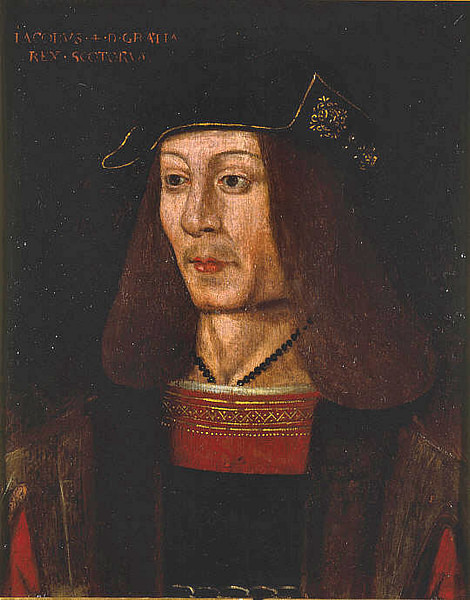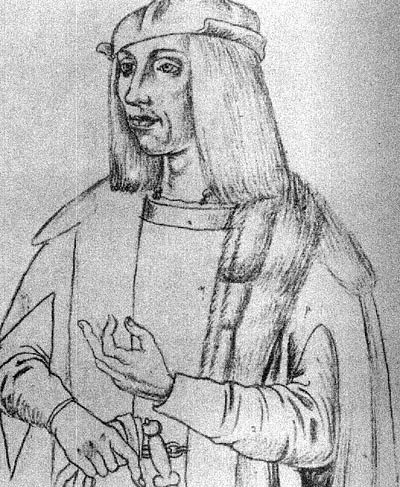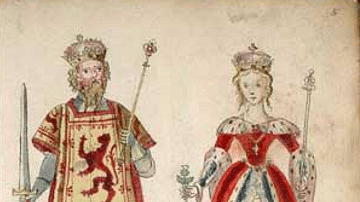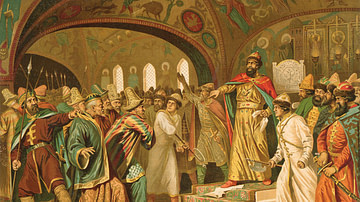
James IV of Scotland ruled as king from 1488 to 1513. He succeeded his father James III of Scotland (r. 1460-1488) and became one of the most popular of the Stuart kings. James sought to apply justice in every corner of his realm, he created Scotland's first navy, and he promoted such innovations as the printing press. The royal houses of England and Scotland were joined in 1503 when James married Margaret Tudor, daughter of Henry VII of England (r. 1485-1509). James IV was killed along with the flower of Scotland's nobility when he lost the Battle of Flodden against the English in September 1513. He was succeeded by his son James V of Scotland (r. 1513-1542) and so the royal Stuart line continued.
Succession & Family
James III of Scotland was one of the most unpopular kings the country had ever seen. Alienating the nobility, his brothers, and eventually even his own son and heir, the king was twice abducted and then killed during a skirmish in June 1488. The last episode had seen rebel barons led by the Earl of Argyll attempt to promote James' III's eldest son, also called James, as king. Struck with remorse for his role in his father's demise, James was said to have worn an iron chain around his waist each Lent thereafter as a penance. Nevertheless, he succeeded his father and became James IV of Scotland, continuing the line of Stewarts on the throne that had begun with Robert II of Scotland (r. 1371-1390).
James IV was born on 17 March 1473 and so he was only 15 when he succeeded his father and became king. His coronation was held at Scone Abbey on 26 June 1488, but it was not until several years of political jostling amongst the nobility had played themselves out that he could rule Scotland in his own right, that is from around 1495. James' mother was Margaret of Denmark, who had died in 1486.
Back in 1474, James III had arranged for his eldest son to marry Cecily, the daughter of Edward IV of England (r. 1461-1470 & 1471-1483), but this never came about as Edward IV died and the long dynastic dispute known as the Wars of the Roses (1455-1487) continued to destabilise England. Henry Tudor won those wars and established the royal house of Tudor with himself as its first king, Henry VII of England. Relations between Scotland and England became more friendly than usual when James married Margaret Tudor (1489-1541), Henry VII's daughter, on 8 August 1503. The couple's union was described by the acclaimed contemporary poet William Dunbar as 'the marriage of the Thistle and the Rose', and their one surviving child (from six), also called James, was born in 1512.

Personality & Policies
James IV cut a dashing figure thanks to his height, good looks, and interest in chivalry and associated pursuits like hunting, falconry, archery, and jousting. The king was intelligent, spoke seven languages, and was interested in innovations. For example, the king had a personal collection of five handguns. A fleet of warships was built from 1502, some with French aid (see below), and so Scotland's first navy was created, which provided a useful defence against piracy in the North Sea and protection for the coast of Lothian, a favourite target of English ships in the late Middle Ages. Amongst the ships was the Great Michael, launched in October 1511 and then the largest active warship in Europe.
James took a keen interest in chemistry, alchemy, and dentistry, often practising these himself. In Aberdeen, the king created the first department of medicine in a British university in 1495 and founded the surgeon's college in Edinburgh. 1507 saw James introduce to Scotland its first printing press. Not always successful in his schemes, one close collaborator was encouraged to try and fly off the battlements of Stirling Castle, but his mechanical wings came unstuck, and he landed in a pile of manure. There were some unpopular decisions, too, like the 1491 laws which banned football and golf because it was felt that too many people were playing these sports and not practising archery, then considered important for warfare.
In true Renaissance fashion, James was a great patron of the arts, supporting musicians (notably Gaelic harpists), poets, and artists at his court, which became renowned for its spectacles and pageants. In contrast, the king had a reputation for keeping company with prostitutes, and he fathered many illegitimate children, many of whom were raised alongside his legitimate offspring in Stirling Castle.

James consolidated the control of the Crown over all parts of Scotland, by now pretty well established, but there were still some pockets of independence. The king travelled widely across Scotland, making himself visible to his subjects. In this way, he could resolve important family disputes in person and ensure that justice was done in his local courts. The king also performed a number of pilgrimages within Scotland. James was loyal and generous to those families that had helped him in his troubles with his father. Additionally, the king made sure his royal council evenly represented the noble families of Scotland. As a consequence of these policies, the heart of his kingdom was largely stable and peaceful throughout his reign.
Several military expeditions in the 1490s brought the Lords of the Isles in the far north better under control, particularly the troublesome MacDonalds. The Scottish Highlands, also wild and remote, had always been a source of trouble for Scottish monarchs, and here James relied on the Campbell and Gordon clans to govern in his name. Elsewhere, clan leaders were now held accountable for the actions of their clansmen. State revenues tripled during James' reign thanks to his efficient application of feudal laws when estates changed hands and the imposition of taxes on the clergy. The king was thus able to spend freely on significant building projects like the new palace at Holyrood, a palace at Falkirk, a new royal chapel at Stirling Castle, and a new Great Hall for Edinburgh Castle. Many of these buildings included the latest ideas in Renaissance architecture, further enhancing the king's reputation as a man of new ideas and a monarch who was moving Scotland from the medieval world into that of the early modern.
Relations with England
James' foreign policy included intervention in the civil war in Denmark in 1501-2, the king no doubt influenced by his mother's connections there. It was the volatile relations with England, though, that defined James IV's reign. In 1495-97 James hosted the pretender to the English throne, Perkin Warbeck (1474-1499), and raided northern England several times using Warbeck as a front. In November 1499 Warbeck confessed that he was an imposter with no royal blood, and he was executed. Peace was then established with England thanks to James' marriage but, unfortunately, this happy state would not survive Henry VII's death in 1509. The most significant consequence of the marriage, which neither monarchies seemed all that enthusiastic about, would come much later when in 1603, James' great-grandson James VI of Scotland (r. 1567-1625) was invited to become the king of England (as James I of England), and so the two crowns were unified.

The Disaster of Flodden
The next king south of the border, Henry VIII of England (r. 1509-1547), was ambitious to be seen as a powerful Renaissance prince in European circles, and he set his sights on France, which he invaded in 1513. Aware of this threat, the French had renewed the alliance with Scotland, their traditional allies (a relationship known as the 'Auld Alliance'), the year before. As part of this treaty, James was given supplies of timber and a number of shipwrights with which to extend his navy. A force of 13 ships and 4,000 men was then sent to Normandy to aid Louis XII of France (r. 1498-1515). As it turned out, the fleet was beset with bad weather, failed to link up with the Breton and French fleets, and the Great Michael even suffered the ignominy of running aground. Nevertheless, the support for Louis XII made it abundantly clear that the Scottish king did not put much value on his 1502 peace treaty with England which his marriage had only flimsily sealed.
As part of his agreement with France, James was obliged to attack England on land, which he did with an army numbering some 20,000 men (although some historians would double that figure). There were early successes such as the capture of Norham, Wark, Etal, and Ford Castles. However, the Scots army was ill-equipped and unpaid so that it was no match for its opposition, even if it did have a number of cannons commandeered from Edinburgh Castle.
The English army, led by the Earl of Surrey, met the Scottish force, by now depleted by illness and desertions but still significant in size, on 9 September 1513 at Flodden. The English managed to tempt the Scottish forces down from the safety of Flodden Hill and, in treacherous conditions of wind, rain, and thick mud, they won a resounding victory. James IV was killed along with some 10,000 Scots. The English, in stark contrast, lost only 1,500 men. Perhaps more significantly for the management of the kingdom, Scotland also lost a huge slice of its nobility. Amongst the dead were 9 earls, 14 barons, and three bishops, not to mention the king, of course. James' body was embalmed and sent to Berwick and then possibly to London, but its ultimate fate is not known for certain.
Successor
The king's eldest son James thus became James V of Scotland, but he was only one year old at the time. During the king's minority, his mother Queen Margaret remarried in 1514 to the Earl of Angus and had to battle with John Stewart (c. 1484-1536), the Duke of Albany and grandson of James II of Scotland (r. 1437-1460), for the regency. Reaching maturity, James V married twice, both his queens being French: Madeleine de Valois (1521-1537), daughter of Francis I of France (r. 1515-1547) and then Mary of Guise (1515-1560). The king did his popularity no good whatsoever with his policy of high taxes and attacks on the nobility, most infamously the sister of the Earl of Angus, who was burnt at the stake. Henry VIII then attacked Scotland in force and won another resounding victory, this time at Solway Moss in November 1542. James V died within a month of the loss. With no male heirs, James' daughter with Mary of Guise, Mary, Queen of Scots (r. 1542-1567), inherited the throne and, as she also became queen of France (r. 1559-1560), the conflict with the Tudors in England rolled on.





